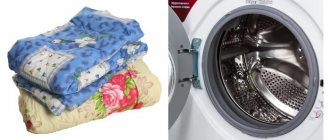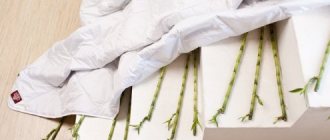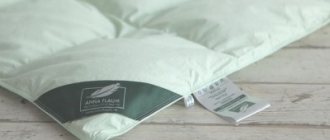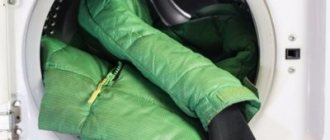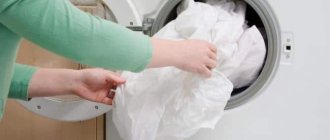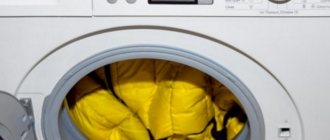There are a lot of fillings for blankets. They can be synthetic, such as padding polyester and holofiber, or of natural origin - wool, down, bamboo or even coconut. However, regardless of the type chosen, any blanket, like any bedding, is prone to rapid contamination due to regular contact with the human body. This is where questions arise related to finding a suitable cleaning method - how to do it correctly, and most importantly, is it even possible to wash a down, wool and synthetic blanket in an automatic washing machine. We will deal with these questions further in the article.
Cotton blanket
This type of blanket is usually inherited from past times. The cotton blanket is quite heavy, but at the same time very warm, which is important on frosty winter nights. However, in addition to its advantages, a cotton blanket also has a disadvantage. The disadvantage can rightly be called the difficulty of cleaning a cotton blanket.
When wet, the already heavy blanket becomes simply too heavy to lift, and the fragile housewife clearly cannot do without the help of strong male hands. In addition, when washed, the cotton wool in a blanket can clump into clumps, causing it to become lumpy. Such a blanket will take a very long time to dry and is unlikely to dry in an apartment without becoming saturated with the smell of dampness and mustiness.
It is recommended to clean a cotton blanket using a dry method, washing only local areas. And to get rid of dust, you can beat the product outside with a beater.
You can clean a cotton blanket by following these recommendations:
- First of all, the blanket must be shaken off and cleaned of dust so that when it comes into contact with the product and water, it is not absorbed into the surface of the material. You can knock the dust out on the street.
- Prepare a cleaning product from previously grated laundry soap or liquid laundry detergent, dissolving them in warm water.
- Using a sponge, apply the product to the surface and rub gently, being careful not to wet the filler.
- Use a clean sponge and water to remove the cleaning compound from the treated area of the blanket.
When deciding how to wash a wadded blanket in an automatic washing machine, it is important to take into account the fact that a large blanket will be very heavy when wet, which in most cases can lead to damage to the washing machine. For this reason, it is recommended that only baby blankets be machine washed. The following points should be taken into account:
- The temperature should be set no higher than 40°C.
- It is recommended to select the washing mode: “Delicate”, “Hand wash”, “Wool”, depending on the automatic machine model.
- Disable the “Spin” mode or set it to minimum speed.
- Instead of washing powder, use soap shavings or gel for washing woolen items, as the powder will not be completely washed out of the filler.
- Throw 5-6 tennis balls into the drum with a blanket, after washing them. This will prevent the filler from clumping during washing.
- It is recommended to remove local contamination in the form of baby urine or spilled drinks in advance by washing the blanket locally.
- After washing, remove the blanket from the drum immediately, without allowing it to sit wet.
- Lay the blanket out on a flat, horizontal surface, preferably outdoors. To protect from direct sunlight, cover with a thin sheet. When drying indoors, direct a stream of warm air from the heater towards the washed blanket.
Important! It is not recommended to dry a blanket made of cotton filling in a vertical position, as the filling will slide down to the edges and the blanket will lose its shape and thermal insulation properties.
Blanket for newborn
Flannelette blankets are very often used for newborn babies due to their environmental friendliness, softness, light weight, and good performance properties.
If this is an item that is intended for a small child, then washing should be carried out exclusively with powders and gels intended for children's underwear.
A flannelette blanket should only be used with a duvet cover, which must be replaced regularly. If stains occur, they should be removed immediately. This item, like the rest of your baby’s clothes, needs to be washed on time, avoiding old stains from urine or food.
Blanket
Unlike a cotton blanket, the wool version is easier to wash. However, before you wash a wool blanket in the washing machine, you should consider a number of basic points:
- Washing is allowed only in the “Delicate” and “Wool” modes.
- The washing temperature should not exceed 30°C, whether it is a camel blanket or a sheep's wool filler.
- As a cleaning agent, you should use special gels for caring for woolen items: “Vorsinka”, “Euro Wish”, “Formil Wool” in gel form, “Denkmit” or “HEY-Sport”.
- Before washing, woolen items should be placed in a special bag to avoid clogging the drain filter with wool.
- Rinse your wool blanket at the same water temperature as when washing.
- After rinsing, the water should drain from the blanket on its own without spinning.
- It is recommended to dry in a horizontal position away from direct sunlight.
Important! When asking whether you need to wash a new wool blanket, you should take into account that to remove the unpleasant odor, you can simply ventilate the blanket in the open air. It is recommended to wash a wool blanket only to remove dirt.
Characteristics of fillers
How to wash the question never arises for the housewife near the shelf with bedding. The natural desire to wrap yourself in a soft blanket on a winter night, so that it is not heavy with natural or synthetic filling, wins.
On a cool summer evening, you also can’t do without a comfortable blanket. They equip the bedroom with similar products for a long time, so when choosing them, preference should be given not to affordable cost, but to the main criterion - quality. The brand of a well-known manufacturer will not allow you to risk your reputation in order to stoop to low-grade filler or poisonous paint.
Companies with a decent image produce products in accordance with:
- with sanitary standards;
- hygienic requirements;
- strict step-by-step control.
What a comfortable bedspread will look like after washing should concern the buyer in order to provide for the proper care of the bedding accessory in advance.
Cotton blankets, initially warm and soft, can turn, despite the budget option, into a dust collector with a lumpy core. Incorrect chemical treatment leaves stains.
Wool products are treated with care; they are endowed with positive characteristics:
- retain heat;
- weigh little;
- create a microclimate;
- hygroscopic;
- medicinal.
Blanket filled with bamboo material:
- fibers protect against harmful microorganisms;
- warms;
- endowed with medicinal properties.
Silk products are considered elite:
- soft;
- elastic;
- do not fall off;
- wear-resistant;
- durable.
Synthetic products cause a wary reaction in the consumer, although the characteristic signs of some properties do not lag behind those of natural substances:
- low weight and volume;
- easy care;
- long service life.
In any case, having chosen, they think about easy but proper care of the item and decide who it will serve: an adult or a child.
Down and silk duvet
The filling in a duvet is just as sensitive to washing as in the case of a wadded duvet. The main difficulty in the question of how to wash a duvet in an automatic washing machine is that down, like cotton wool, can fall out in the cells of the duvet when wet. In addition, prolonged drying can lead to the appearance of damp and moldy odors. For this reason, manufacturers of down-filled duvets recommend dry washing or dry cleaning.
However, if washing a duvet is unavoidable, then the recommendations are similar to those for washing a wadded duvet:
- Temperature regime is not higher than 30°C.
- Washing mode “Delicate” or “Hand wash”.
- Instead of washing powder, use specialized cleaning products.
- Place several tennis balls in the drum to prevent the fluff from clumping.
- Drying is carried out only on a horizontal surface away from sunlight.
To wash a silk blanket at home, it is important to know that in this case the product has a zipper, so the filling can be easily removed from the cover. The cover is washed according to the recommendations on the product tag, and the filling is soaked in a mild soapy solution for several hours, after which it is carefully rinsed in clean water and dried on a flat horizontal surface.
How to get rid of lumps
Fluff, feathers, and cotton wool tend to form lumps when washed, which are difficult to wash and dry. If the cotton wool or cotton is stuck in a ball, it will not be possible to resuscitate the item. Down and feathers will not form clumps during washing if you put special balls in the drum that break up the filler. During the drying process, manually breaking up the feathers and down will speed up the drying process and prevent caking of the material and the appearance of a musty smell.
Beating the fillers with a carpet clapper or vacuuming will loosen the filler and speed up drying. You should not exhaust, turn over or vacuum a wet product; excess water should drain and the blanket should dry out.
Synthetic blanket (sintepon and holofiber)
The easiest blankets to wash are those with artificial fillings. We are talking about padding polyester and holofiber. Dust mites do not live in them, and synthetics are not afraid of mold, dampness, or odors. At the same time, they are soft and retain heat well. The answer to the question whether holofiber and padding polyester can be washed is definitely “yes”. To wash a synthetic blanket made of padding polyester or holofiber, you should consider some recommendations:
- Sintepon can be washed at a temperature not exceeding 40°C, and holofiber at a temperature not exceeding 60°C.
- For washing, you can use half the amount of detergent as for other types of blankets.
- After spinning, just shake the filler.
- Drying is permitted in both horizontal and vertical positions. Even if left in the drum for a day, the synthetic filler will not be damaged.
patchwork quilt
The peculiarity of patchwork quilts is that they are made from a large number of pieces (rags). Since damaged pieces may come off during washing, you should repair the blanket before washing. And due to the large number of multi-colored rags, you should add a small amount of table vinegar to the cleaning product (1 tablespoon per liter of liquid) so that the blanket does not fade. For the same reason, washing a quilt should be done in non-hot water.
What means can be used?
Most often, parents resort to using baby powders that are recommended by pediatricians and do not contain any harmful chemical compounds. They cost a little more due to the use of alternative components, but they do not cause an allergic reaction, breathing problems, or irritation.
You can also use fragrance-free baby soap shavings for blankets and other items. It takes longer to rinse the product, but it is considered the best option for any material.
Bamboo and coconut blanket
Plant-based filler does not like high temperatures, curling, and is also afraid of bleaches. To wash a coconut or bamboo blanket in a washing machine, you should adhere to the following rules:
- Washing temperature - 30°C.
- Spin only at minimum speed.
- Dry horizontally on a flat surface.
Important! Do not use bleach to wash coconut and bamboo blankets.
Machine washable
Let's figure out how to properly wash a blanket in an automatic machine. The possibility of using a washing machine depends on the weight and overall characteristics of the blankets. The calculation is made according to two parameters:
- Weight. The weight of the product should not exceed the maximum load of the washing machine drum.
- Dimensions. After placing the blanket in the drum, there should still be some space left in it.
To wash a blanket in a washing machine, it must be folded several times until the dimensions are slightly smaller than the depth of the drum, then the product should be rolled into a roll and placed in the washing machine.
It is worth noting! During washing, the blanket will straighten itself as needed and be evenly distributed throughout the drum.
Cleaning products are loaded into the appropriate compartments. In this case, instead of washing powder, it is better to use gels and liquid products, since they dissolve in water much faster and are completely washed out of the blanket fibers when rinsing. To add softness, you can add a small amount of fabric softener before washing.
Important! What mode to wash the blanket on depends on the manufacturer’s recommendations indicated on the product tag.
Is it possible?
The peculiarity of the composition of a flannelette blanket is the inclusion of natural cotton fibers, twisted in a special way. Such a thing is created using a special jacquard and napping machine.
Density and better heat retention are achieved by including auxiliary materials - wool, viscose. This composition of the material should be taken into account when choosing a method for washing a blanket.
First you need to study the product label. On it, the manufacturer indicates the fabric composition, washability, optimal processing temperature and other useful information.
Almost all flannelette products can be washed both in a machine and by hand. Restrictions on care may be found mainly in products that contain wool. Improper care can ruin the item.
Handwash
In cases where it is not possible to use an automatic washing machine, you can wash the blanket manually. It is worth noting that the bathtub is the very place where you can wash the blanket by hand, since it simply will not fit into the basin. Let's take a step-by-step look at how to wash a blanket by hand:
- Fill the bath so that the blanket can be completely immersed in water, while taking into account the recommendations on the tag at what temperature to wash the blanket.
- Pour the cleaning agent into the water and stir thoroughly.
- Place the blanket in the bath and submerge completely in water.
- Using the “lift and lower” method, you should wash the blanket for 10-15 minutes. However, since when wet, a large blanket becomes too heavy to lift, you can climb into the bathtub and simply trample it with clean feet like Celentano’s grapes.
- Rinse the blanket in the same way until the cleaning agent is completely removed.
- To wring out a blanket, you need to fold it several times, trample it, then put a stool in the bathtub, put a blanket on it and wait until most of the water drains.
- Start drying.
Important! When deciding which blanket can be washed, you should take into account that down and cotton fillers are more afraid of getting wet than others. Therefore, you should send them to the wash only in extreme cases.
What to do if there are problems - if the filling has rolled up, the blanket has become hard, or an odor has appeared
After improper washing and drying, you can encounter many unpleasant consequences. It is necessary to rewash the product only as a last resort, if the methods from the list below did not help.
How to clean a mattress on a bed at home - secrets of advanced housewives
Here are some common problems and how to solve them:
- Lumps have formed . If simple kneading and shaking does not help, use a vacuum cleaner. You can also try beating with a carpet beating tool.
- Unpleasant smell . To eliminate it, let the product lie outside for some time. Ideal if the weather is windy.
- The material has become hard . In this case, you will have to wash it, but this time be sure to use a good fabric softener.
Most duvet fillers can easily be washed in an automatic machine if done correctly and not too often. For surface stains, it is better to use dry cleaning, so the blanket will last longer.
Don't forget that drying is as important a part of the process as washing itself. A poorly dried product will have to be washed again.
